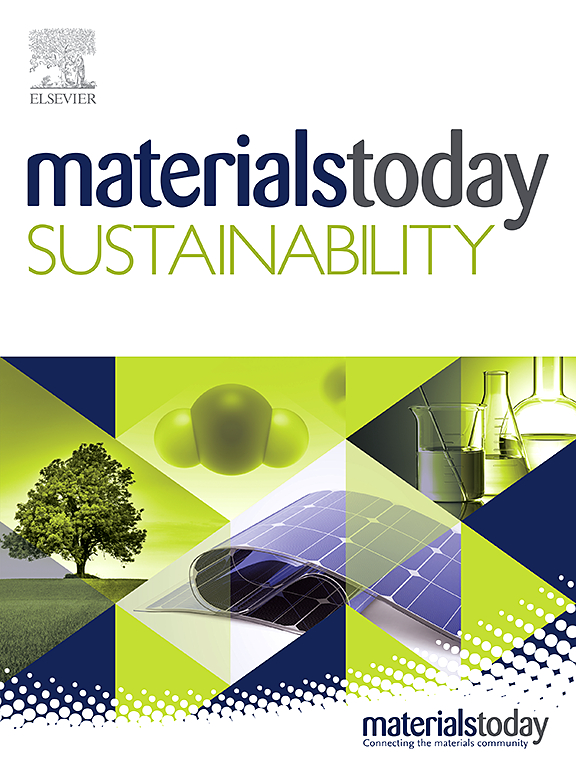Sustainable fused granulate fabrication: the effects of multiple recycling processes on mechanical properties of recycled polycarbonate
IF 7.9
3区 材料科学
Q1 GREEN & SUSTAINABLE SCIENCE & TECHNOLOGY
引用次数: 0
Abstract
This study explores the potential of polycarbonate (PC) using a novel 3D printing technique such as fused granulate fabrication (FGF), focusing on the effects of multiple recycling cycles on thermal stability, mechanical properties and microstructural integrity. Thermal stability analysis of FGF-printed recycled polycarbonate (rPC) shows a 12.5 % decrease in glass transition temperature (Tg) and slight degradation in onset degradation temperature Tonset after 10 recycling cycles. FTIR spectra shows initial improvements in the rPC structure after the 1st cycle, followed by degradation in subsequent cycles, confirming chain scission and reduced functional groups. Mechanical testing indicates that tensile strength increases from 54.96 MPa at the 1st cycle–68.59 MPa at the 3rd cycle due to improved polymer chain alignment but reduced significantly to 27.31 MPa by the 10th cycle due to degradation. The maximum flexural strength of 76.4 MPa was oberved at the 3rd cycleand then begins to decline from the 5th onwards. Impact strength shows a steady decrease, from 3.29 kJ/m2 at the 1st cycle–2.4 kJ/m2 at the 10th cycle, reflecting molecular breakdown and reduced ductility. Fracture surface analysis reveals a transition from ductile to brittle failure as the number of recycling cycles increased. In terms of 3D printing efficiency, FGF significantly reduced printing time compared to fused filament fabrication (FFF), with up to an 84 % time saving, demonstrating the FGF potential as a cost-effective and sustainable alternative for rPC. These results contribute to comprehensively understanding the trade-offs and benefits of using rPC in Additive Manufacturing, providing insights into the sustainable use of rPC for FGF-printed products.
可持续熔融制粒:多种回收工艺对再生聚碳酸酯力学性能的影响
本研究利用新型3D打印技术(如熔融颗粒制造(FGF))探索了聚碳酸酯(PC)的潜力,重点研究了多次回收循环对热稳定性、机械性能和微观结构完整性的影响。热稳定性分析表明,fgf打印的再生聚碳酸酯(rPC)经过10次循环后,玻璃化转变温度(Tg)下降12.5%,起始降解温度(Tonset)略有下降。FTIR光谱显示rPC结构在第一次循环后开始改善,随后在后续循环中降解,证实链断裂和官能团减少。力学测试结果表明,由于聚合物链排列的改善,聚合物的抗拉强度从第1个循环的54.96 MPa增加到第3个循环的68.59 MPa,但由于降解,第10个循环的抗拉强度明显降低到27.31 MPa。第3个周期的抗弯强度达到最大值76.4 MPa,第5个周期后开始下降。冲击强度呈稳定下降趋势,从第1次循环时的3.29 kJ/m2下降到第10次循环时的2.4 kJ/m2,反映了分子击穿和延性降低。断裂面分析表明,随着循环次数的增加,断裂从延性破坏向脆性破坏转变。在3D打印效率方面,与熔融长丝制造(FFF)相比,FGF显著缩短了打印时间,节省了高达84%的时间,证明了FGF作为rPC的成本效益和可持续替代品的潜力。这些结果有助于全面了解在增材制造中使用rPC的利弊,为rPC在fgf打印产品中的可持续使用提供见解。
本文章由计算机程序翻译,如有差异,请以英文原文为准。
求助全文
约1分钟内获得全文
求助全文
来源期刊

Materials Today Sustainability
Multiple-
CiteScore
5.80
自引率
6.40%
发文量
174
审稿时长
32 days
期刊介绍:
Materials Today Sustainability is a multi-disciplinary journal covering all aspects of sustainability through materials science.
With a rapidly increasing population with growing demands, materials science has emerged as a critical discipline toward protecting of the environment and ensuring the long term survival of future generations.
 求助内容:
求助内容: 应助结果提醒方式:
应助结果提醒方式:


